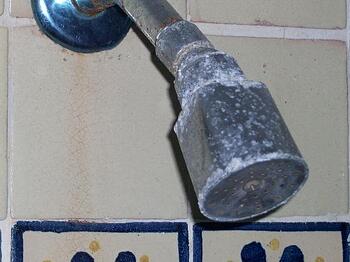 When showering, do you find your shower head is spraying unevenly? Or perhaps the shower head is bit discolored. Both issues may have been caused by mineral deposits that accrue over time. Instead of using harsh chemicals or replacing the shower head completely, take a moment and see if one of these options helps. Before moving forward, you need to determine whether or not to remove the shower head from the pipe or hose it is connected to. If you are unable to remove the shower head or would prefer not to, there is another option, discussed later, that you can try.
When showering, do you find your shower head is spraying unevenly? Or perhaps the shower head is bit discolored. Both issues may have been caused by mineral deposits that accrue over time. Instead of using harsh chemicals or replacing the shower head completely, take a moment and see if one of these options helps. Before moving forward, you need to determine whether or not to remove the shower head from the pipe or hose it is connected to. If you are unable to remove the shower head or would prefer not to, there is another option, discussed later, that you can try.
Option #1 – The Simmering Method
After having safely removed the shower head, fill a pan with enough vinegar to submerge the shower head and place it on the stove. Disassemble the shower head and place all parts of it in the vinegar. Bring the vinegar in the pan to a simmer, but do not allow the vinegar to boil, and make sure to not turn the heat source up too high. This may melt the shower head! Allow the shower head to sit in the simmering vinegar long enough to break up the mineral deposits. Once you are satisfied that the shower head is clear of deposits remove the shower head from the vinegar, rinse it out, and reassemble the shower head. Once the shower head is back together, reattach it and turn on the shower to ensure that it is now unclogged and working properly.
Option #2 – The Warm Soak Method
If the idea of placing the shower head in simmering pan or on direct heat is worrisome, try the warm soak method. With this method, simply warm up the vinegar and then remove it from its heat source. Place the shower head in the warm vinegar and leave it for an hour or two. If the shower head does not appear clean enough, it can be allowed to sit for a longer period of time. Again, once satisfied, reassemble and reattach everything, then turn on the shower to ensure its unclogged and working properly.
Option #3 – The Cold Soak Method
This option requires no heat at all, it only calls for the vinegar, a container to soak the shower head, and approximately 24 hours. Simply fill a pan or bowl with enough vinegar to submerge the shower head, place the shower head in the vinegar and let it sit for the next 24 hours.
Option #4 – The Cold Soak Variation
If you are unable to remove your shower head or chose not to, then try this method. It’s Option #3, but with a few changes. First, you will need a sandwich bag or a durable shower cap. You will also need a rubber band, twine, or a hair tie. Next, fill the bag with vinegar and place it over the shower head so that the shower head is completely submerged in the vinegar. Lastly, tie the bag around the shower head, making sure that that bag stays securely fastened so that it does not slip off or leak. Allow the bag to remain on the shower head for 24 hours. Like the previous methods mentioned, once the 24 hours is up remove the bag from the shower head and turn on the shower to ensure the shower head is not unclogged and working properly.
If you are still experienceing pressure issues in your shower after fixing your shower head, you may want to consider investing in a low-flow shower head. These products allow less water through them, increasing your shower's pressure while still distributing the water evenly. Your hot water will even last longer while you're in the shower!
If you want a professional, licensed plumber to examine your home's plumbing system, and resolve your issues in a timely manner, contact Warner Service to set up an appointment. As always, If you would like more great information like this delivered to your inbox every week, subscribe to the blog with the button below.


